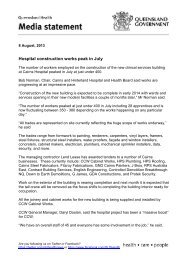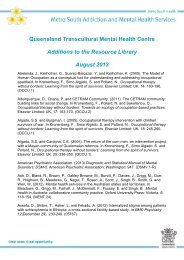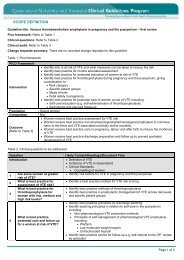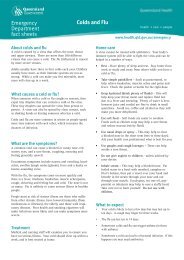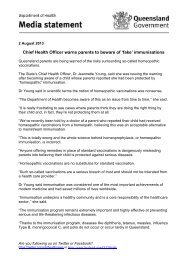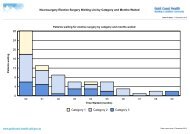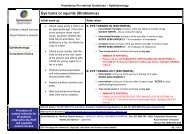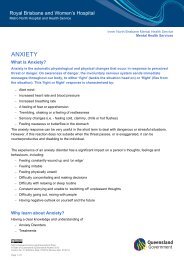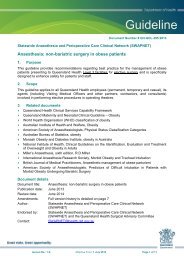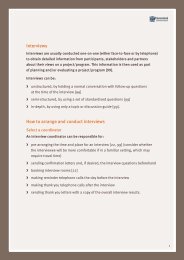Paediatrics - Queensland Health - Queensland Government
Paediatrics - Queensland Health - Queensland Government
Paediatrics - Queensland Health - Queensland Government
Create successful ePaper yourself
Turn your PDF publications into a flip-book with our unique Google optimized e-Paper software.
Ear problems<br />
Acute otitis media (AOM)<br />
Non-discharging painful ear<br />
Recommend<br />
Consult MO immediately if child is < 3 months of age, who is sick or hot, or meets<br />
any of the other criteria outlined at beginning of paediatric section<br />
All children with AOM should be reviewed after four to seven days of treatment or<br />
earlier if deterioration [1]. A second review should take place after completion of<br />
therapy [1]<br />
<strong>Health</strong> clinics have targeted hearing health programs to focus on day care and pre<br />
school children where intervention may prevent ear damage and hearing loss<br />
Personal hygiene in children - washing hands and face is important<br />
Background<br />
In some rural and remote Aboriginal communitites complications of otitis media<br />
are much more common. They include tympanic membrane perforations, CSOM,<br />
OME and mastoiditis. This is the reason that antibiotics are recommended in these<br />
children, while in low risk populations the advantage of antibiotics is small<br />
Related topics<br />
Upper respiratory tract infection - child<br />
Pneumonia<br />
Acute asthma<br />
Bronchiolitis<br />
Assessment of the ear<br />
1. May present with<br />
• A history of acute onset of signs and symptoms<br />
• Young child may present with irritability, disturbed sleep, pulling at ears, sometimes<br />
vomiting and diarrhoea<br />
• Fever or upper respiratory symptoms<br />
• Pain clearly originating from the ear<br />
• Some children will not have pain but a red bulging drum is found on routine exam<br />
2. Immediate management Not applicable<br />
3. Clinical assessment<br />
• Obtain a complete patient history. See Assessment of the ear<br />
• Perform standard clinical observations<br />
• Perform physical examination. See Assessment of the ear Look for inflammation<br />
with a red bulging tympanic membrane and loss of light reflex<br />
4. Management<br />
• Provide adequate and regular analgesia<br />
See Simple analgesia back cover<br />
• Consult MO if child:<br />
- - < 3 months of age, who is sick or hot<br />
-- temperature over 38° C or below 36°C<br />
-- has any rash, increased respiratory rate or respiratory distress or meets any<br />
of the other criteria as outlined at beginning of paediatric section - this child<br />
needs to be managed as a septic infant<br />
• Spontaneous resolution of AOM is unlikely in high risk populations therefore if not<br />
allergic to penicillin treat with amoxycillin [1]<br />
Primary Clinical Care Manual 2011 Controlled copy V 1.0 583



